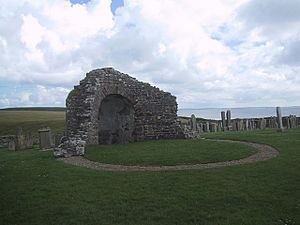Helga Moddansdóttir facts for kids
Helga Moddansdóttir was an important woman in the early 12th century. She was the partner of Haakon Paulsson, who was the Earl of Orkney from 1105 to 1123.
The Orkneyinga saga, an old Norse story, tells us that Helga was the daughter of Moddan. He was a rich and well-known farmer. Helga and Earl Haakon had three children together. Her family was very powerful in northern Scotland, especially near Helmsdale in Sutherland.
Even though we don't know much about Helga's daily life, she and her sister Frakkök, along with their children, had a big impact on the politics of Orkney, Caithness, and Sutherland. One famous story about her involves a poisoned shirt that supposedly killed her son Harald.
Contents
Helga's Powerful Family

Helga's family, sometimes called "Clan Moddan," became very important in the Earldom of Orkney after Earl Magnus Erlendsson died around 1115. Her father, Moddan, was a respected farmer.
Helga had several brothers and sisters, including Angus "the Generous," Frakkök, and Þorleif. It's interesting that her family had both Norse (Viking) and Gaelic (Scottish) names. This suggests that her family had a mixed background, with some ancestors from Celtic lands and others from Norse areas.
The Orkneyinga saga describes Helga as Earl Haakon's partner. They had children together, and their family connections played a big role in the region's history.
Helga's Children and Their Influence
Helga and Earl Haakon had three children who became very important figures:
- Harald "Smooth-tongue" Haakonsson: He became Earl of Orkney after his father died. He ruled alongside his half-brother Páll "the Silent." Harald died in 1130, and the saga suggests his death was part of a plot involving Helga and her sister Frakkök.
- Ingibjörg Hakonsdóttir: She married Olaf Morsel, who was the King of the Isles. Their daughter, Ragnhild, married Somerled. From this marriage came many powerful Scottish clans, including Clan MacDougall, the Lords of the Isles, Clan Donald, and Clan MacAlister.
- Margaret: She married Matad, Earl of Atholl. Their son, Harald Maddadsson, became Earl of Orkney from 1138 to 1206. The Orkneyinga Saga calls him one of the three most powerful Earls of Orkney ever.
After Earl Haakon died around 1123, Harald and Páll became joint earls. People in Orkney were worried about how the two brothers would get along. Helga and her sister Frakkök had a lot of influence over Earl Harald. This led to political problems and two groups forming, each supporting one of the earls.
The Legend of the Poisoned Shirt

The Orkneyinga saga is a mix of historical facts and exciting legends. One of the most famous stories about Helga is the tale of the poisoned shirt.
The saga says that around Christmas in 1130, Frakkök and Helga were staying at Earl Harald's estate in Orphir. They were preparing for a big feast. The two sisters were sewing a beautiful, snow-white garment decorated with gold. This special garment was meant for Earl Páll.
However, Earl Harald saw the lovely shirt and, despite his mother and aunt's protests, decided to try it on himself. As soon as he put it on, he shivered and felt a terrible burning pain. Soon after, he died. The saga says that Earl Páll immediately took control of his half-brother's belongings and became very suspicious of Helga and Frakkök.
Banishment from Orkney

After Earl Harald's death, Helga and Frakkök were sent away from Orkney. They returned to their home in Dale. Later, Frakkök was killed by Sweyn Asleifsson after she tried to attack Earl Páll with troops she and her grandson Olvir "Brawl" had gathered.
The saga doesn't say what happened to Helga after this. However, it does mention that in the power struggle that followed Earl Harald's death, Sweyn Asleifsson captured Earl Páll. He then delivered Earl Páll to Helga's daughter Margaret in Atholl. Earl Páll was never seen again after this.

